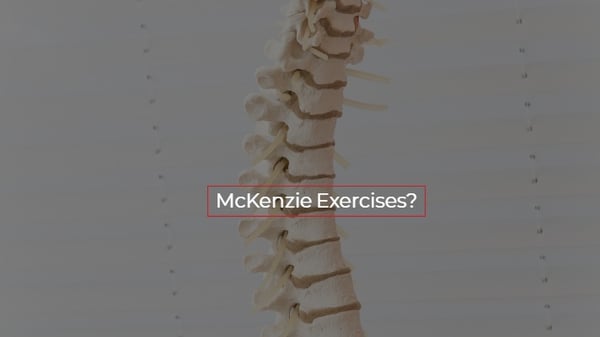Low back pain is super common and about 80% of adults suffer it at one point or another in their lives. So if you’re experiencing it, take a bit of comfort in knowing that you’re far from alone. That said, there’s thankfully a phenomenal tool in the treatment toolbox and it’s called the McKenzie Method. The McKenzie Method is a comprehensive system for the evaluation, diagnosis, and prescription of the proper treatment for people with low back pain and other forms of spinal pain like sciatica.

Before we look more at the McKenzie Method and its classifications, we’re going to quickly review common causes that put you at risk for low back pain/spinal pain.
Risk factors for low back pain
There are certain factors that make you more susceptible to developing low back pain, and they are:
1. Individual and lifestyle habits: If you don’t exercise regularly and you lead a sedentary lifestyle, there’s a high chance you'll develop low back pain. The same is also true if you’re overweight.
2. Physical or biomechanical factors: When you frequently lift heavy things (especially if you also have bad posture), you’re very likely to develop some form of low back pain. Issues like whole body vibration such as when you’re driving, and bending and twisting for prolonged periods of time can also put you more at risk of getting pain in your lower back.
What exacerbates low back pain?
Low back pain is caused by many things - injury, bad posture, sciatica, muscle overuse… but one thing that aggravates nearly all low back pain is a poor sitting position. Additionally, the fact that many of us spend almost all day in positions where our spines are flexed and rarely extended worsens it.
When should the McKenzie Method be used?
McKenzie exercises are best used:
- When the pain is present in the lower back, and in areas such as the buttocks and legs, like people experiencing sciatic pain down their leg.
- When the pain is mechanical. This means that the nature of the pain changes over time and depending on the physical activity being performed.
- When the patient is otherwise generally healthy
When should McKenzie exercises not be used?
There are certain times when a physical therapist/provider shouldn’t prescribe the Mckenzie method and its exercises. While these are quite uncommon in the first place, MDT should be avoided when a patient has serious spinal pathology, cauda equina syndrome, cancer, spinal cord damage, infections, fractures or widespread impairment of the nerves on the spinal cord.
So, when a provider has determined that you can and should be treated with the McKenzie exercises, they’ll categorize your low back pain in the one of three classifications:
- Derangement syndrome: This is the most common type of pain, and it occurs because there’s a problem with the normal resting position and movement of a joint. The problem could be an impediment such as a lumbar disc protrusion.
- Dysfunction syndrome: This is as a result of load or stress being put on damaged/impaired soft tissue. The problem with the soft tissue may be that it didn’t properly heal from a previous injury, or it’s scarred or shortened.
- Postural syndrome: This type of pain is caused by problems with your posture. Things like slouching while sitting for long periods of time contribute to this.
- Others..yes, there are always the outliers.
The provider will prescribe treatment and exercises to help ease your pain, reduce the inflammation and promote the healing of your damaged tissue. Some of the exercises and stretches you can expect to do are low back flexion exercises, standing lumbar stretches, flexion rotation exercises, press ups, and prone props. You should know that you’ll likely not be asked to perform all, or even most of these exercises. Your provider will determine the one that’s the most appropriate for the kind of pain you’re experiencing.
Once you begin them, it’s likely that your pain will start reducing within a few months, and the best part is that these exercises help you prevent the low back pain/spinal pain from coming back!
Sources:
https://www.ncbi.nlm.nih.gov/pubmed/11441733 - Biomechanical and psychosocial risk factors for low back pain at work.
Kerr MS, Frank JW, Shannon HS, Norman RW, Wells RP, Neumann WP, Bombardier C; Ontario Universities Back Pain Study Group.
http://www.mckenzieinstitute.org/patients/what-does-it-involve/ - THE MCKENZIE INSTITUTE INTERNATIONAL
https://www.researchgate.net/publication/46220202_Psychosocial_risk_factors_for_chronic_low_back_pain_in_primary_care-a_systematic_review - Psychosocial risk factors for chronic low back pain in primary care-a systematic review
https://www.verywell.com/mckenzie-exercises-for-your-low-back-2696222 - McKenzie Exercises for Your Lower BackBy Brett Sears, PT



Share Your Thoughts With Us.